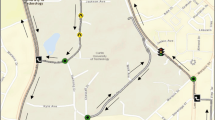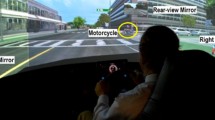Abstract
The purpose of this multi-site randomised controlled trial was to evaluate the effectiveness of a Driving Training Program, an intervention designed for student drivers with autism spectrum disorder (ASD). Participants were 72 student drivers with ASD (ages 16–31) who were randomly assigned to an intervention or control group. Student drivers received ten driving lessons with a professional driving instructor via a standardised driving route. The Driving Performance Checklist was used as the outcome measure to evaluate the driving performance of student drivers during on-road pre- and post-observational drives. Both groups showed an improvement in driving performance, however, the extent of improvement between groups was not significant. Findings showed promising intervention efficacy for training student drivers with ASD to drive.



Similar content being viewed by others
References
Akinwuntan, A. E., Feys, H., DeWeerdt, W., Pauwels, J., Baten, G., & Strypstein, E. (2002). Determinants of driving after stroke. Archives of Physical Medicine and Rehabilitation, 83(3), 334–341.
Almberg, M., Selander, H., Falkmer, M., Vaz, S., Ciccarelli, M., & Falkmer, T. (2015). Experiences of facilitators or barriers in driving education from learner and novice drivers with ADHD or ASD and their driving instructors. Developmental Neurorehabilitation. https://doi.org/10.3109/17518423.2015.1058299.
Ambler, P. G., Eidels, A., & Gregory, C. (2015). Anxiety and aggression in adolescents with autism spectrum disorders attending mainstream schools. Research in Autism Spectrum Disorders, 18, 97–109.
American Psychiatric Association. (2013). Diagnostic and statistical manual of mental disorders (5th ed.). Washington, DC: American Psychiatric Association.
Austroads and the National Transport Commission. (2016). Assessing fitness to drive for commercial and private vehicle drivers: Medical standards for licensing and clincical management guidleines. Retrieved August 21, 2017 from https://austroads.com.au/publications/assessing-fitness-to-drive/ap-g56.
Bölte, S. (2012). Brief Report: The social responsiveness scale for adults (SRS-A): Initial results in a German Cohort. Journal of Autism and Developmental Disorders, 42(9), 1998–1999. https://doi.org/10.1007/s10803-011-1424-5.
Brooks, J., Kellett, J., Seeanner, J., Jenkins, C., Buchanan, C., Kinsman, A., et al. (2016). Training the motor aspects of pre-driving skills of young adults with and without autism spectrum disorder. Journal of Autism and Developmental Disorders, 46(7), 2408–2426. https://doi.org/10.1007/s10803-016-2775-8.
Chee, D., Lee, H., Patomella, A.-H., & Falkmer, T. (2019). Investigating the driving performance of drivers with and without autism spectrum disorders under complex driving conditions. Disability and Rehabilitation, 41(1), 1–8.
Chee, D. Y., Lee, H. C., Patomella, A.-H., & Falkmer, T. (2017). Driving behaviour profile of drivers with autism spectrum disorder (ASD). Journal of Autism and Developmental Disorders, 47(9), 2658–2670.
Classen, S., & Monahan, M. (2013). Evidence-based review on interventions and determinants of driving performance in teens with attention deficit hyperactivity disorder or autism spectrum disorder. Traffic Injury Prevention, 14(2), 188–193.
Classen, S., Monahan, M., & Hernandez, S. (2013a). Indicators of simulated driving skills in adolescents with autism spectrum disorder. The Open Journal of Occupational Therapy. https://doi.org/10.15453/2168-6408.1051.
Classen, S., Monahan, M., & Wang, Y. (2013b). Driving characteristics of teens with attention deficit hyperactivity and autism spectrum disorder. The American Journal of Occupational Therapy, 67(6), 664–673. https://doi.org/10.5014/ajot.2013.008821.
Cohen, J. (1988). Statistical power analysis for the social sciences. New York, NY: Routledge Academic.
Colorosa, S. R., & Makela, C. J. (2014). Integrative literature review: Styles of learning for autism spectrum disorders and human resource development: informing performance management. International Journal of Business and Social Science, 5(13), 1–12.
Constantino, J. N., Davis, S. A., Todd, R. D., Schindler, M. K., Gross, M. M., Brophy, S. L., et al. (2003). Validation of a brief quantitative measure of autistic traits: Comparison of the social responsiveness scale with the autism diagnostic interview-revised. Journal of Autism and Developmental Disorders, 33(4), 427–433.
Constantino, J. N., & Gruber, C. P. (2005). Social responsiveness scale (SRS) manual. Los Angeles, CA: Western Psychological Services.
Corbett, B. A., Constantine, L. J., Hendren, R., Rocke, D., & Ozonoff, S. (2009). Examining executive functioning in children with autism spectrum disorder, attention deficit hyperactivity disorder and typical development. Psychiatry Research, 166(2–3), 210–222.
Cox, N. B., Reeve, R. E., Cox, S. M., & Cox, D. J. (2012). Brief Report: Driving and young adults with ASD: Parents’ experiences. Journal of Autism and Developmental Disorders, 42(10), 2257–2262.
Cox, S. M., Cox, D. J., Kofler, M. J., Moncrief, M. A., Johnson, R. J., Lambert, A. E., et al. (2016). Driving simulator performance in novice drivers with autism spectrum disorder: The role of executive functions and basic motor skills. Journal of Autism and Developmental Disorders, 46(4), 1379–1391. https://doi.org/10.1007/s10803-015-2677-1.
Falkmer, T., Gustavsson, L., Nielsen, B., & Peters, B. (2000). Teaching learner drivers with disabilities: An operation manual for driving instructors. Statens väg-och transportforskningsinstitut., VTI EC research 10.
Halladay, A. K., Bishop, S., Constantino, J. N., Daniels, A. M., Koenig, K., Palmer, K., et al. (2015). Sex and gender differences in autism spectrum disorder: Summarizing evidence gaps and identifying emerging areas of priority. Molecular Autism, 6(1), 36.
Hart, S. G. (2006). NASA-task load index (NASA-TLX); 20 years later. Paper presented at the Proceedings of the human factors and ergonomics society annual meeting (Vol. 50, pp. 904–908). Los Angeles, CA: Sage.
Hatakka, M., Keskinen, E., Gregersen, N. P., Glad, A., & Hernetkoski, K. (2002). From control of the vehicle to personal self-control; broadening the perspectives to driver education. Transportation Research Part F: Traffic Psychology and Behaviour, 5(3), 201–215.
Hendricks, D. R., & Wehman, P. (2009). Transition from school to adulthood for youth with autism spectrum disorders: Review and recommendations. Focus on Autism and Other Developmental Disabilities, 24(2), 77–88.
Hoonakker, P., Carayon, P., Gurses, A. P., Brown, R., Khunlertkit, A., McGuire, K., & Walker, J. M. (2011). Measuring workload of ICU nurses with a questionnaire survey: The NASA Task Load Index (TLX). IIE Transactions on Healthcare Systems Engineering, 1(2), 131–143. https://doi.org/10.1080/19488300.2011.609524.
Huang, P., Kao, T., Curry, A. E., & Durbin, D. R. (2012). Factors associated with driving in teens with autism spectrum disorders. Journal of Developmental & Behavioral Pediatrics, 33(1), 70–74. https://doi.org/10.1097/DBP.0b013e31823a43b7.
IBM Corporation. (2017). IBM SPSS Statistics (Version 25). Armonk, NY: IBM Corp.
Lee, H. C., Cameron, D., & Lee, A. H. (2003). Assessing the driving performance of older adult drivers: On-road versus simulated driving. Accident Analysis and Prevention, 35(5), 797–803. https://doi.org/10.1016/S0001-4575(02)00083-0.
Lindsay, S. (2016). Systematic review of factors affecting driving and motor vehicle transportation among people with autism spectrum disorder. Disability and Rehabilitation. https://doi.org/10.3109/09638288.2016.1161849.
Luciana, M. (2003). Practitioner review: Computerized assessment of neuropsychological function in children: Clinical and research applications of the Cambridge Neuropsychological Testing Automated Battery (CANTAB). Journal of Child Psychology and Psychiatry, 44(5), 649–663.
Michon, J. A. (1985). A critical review of driving behaviour models: What do we know and what we should do? In L. S. Evan (Ed.), Human Behaviour and Traffic Safety (pp. 485–520). Boston, MA: Springer.
Mikami, F., Miyazaki, H., Iwado, M., Odagiri, S., Morito, M., Nanba, T., & Takei, Y. (2018). Understanding characteristics of autism spectrum disorder using ICF-CY. Kawasaki Journal of Medical Welfare, 23(2), 31–42.
Health, N., & Council, M. R. (Eds.). (2007). Australian Research Council, Committee AV-C. National Statement on Ethical Conduct in Human Research. Canberra, ACT: Attorney-General’s Department.
Ozonoff, S., Cook, I., Coon, H., Dawson, G., Joseph, R. M., Klin, A., et al. (2004). Performance on Cambridge neuropsychological test automated battery subtests sensitive to frontal lobe function in people with autistic disorder: Evidence from the collaborative programs of excellence in autism network. Journal of Autism and Developmental Disorders, 34(2), 139–150.
Patomella, A.-H., Tham, K., & Kottorp, A. (2006). P-drive: Assessment of driving performance after stroke. Journal Rehabilitation Medicine, 38, 273–279.
Peräaho, M., Keskinen, E., & Hatakka, M. (2003). Driver competence in a hierarchical perspective; implications for driver education. In Report to Swedish Road Administration (pp. 1–52). University of Turku, Traffic Research. http://media.freeola.com/other/23050/howtoteachthegde-matrix_1.pdf.
Precin, P., Otto, M., Popalzai, K., & Samuel, M. (2012). The role for occupational therapists in community mobility training for people with autism spectrum disorders. Occupational Therapy in Mental Health, 28(2), 129–146.
Precision Vision. (2000). Revised 2000 Series ETDRS Charts-2 meters: Precision Vision. Retrieved July 3, 2017 from http://precision-vision.com/index.cfm/category/34/etdrs-charts.cfm?CFID=34718261&CFTOKEN=87c96276a5c3005e-78591027-A015-34B9-7B01A7CB930534D5.
RANDOM.ORG. (2019). Retrieved January 2019 from https://www.random.org/lists/.
Reimer, B., Fried, R., Mehler, B., Joshi, G., Bolfek, A., Godfrey, K. M., et al. (2013). Brief Report: Examining driving behavior in young adults with high functioning autism spectrum disorders: A pilot study using a driving simulation paradigm. Journal of Autism and Developmental Disorders, 43(9), 2211–2217. https://doi.org/10.1007/s10803-013-1764-4.
Reynolds, C., & Richmond, B. (2008). RCMAS-2-Revised children’s manifest anxiety scale. Los Angeles: Western Psychological Services.
Sheppard, E., Ropar, D., Underwood, G., & van Loon, E. (2010). Brief report: Driving hazard perception in autism. Journal of Autism and Developmental Disorders, 40(4), 504–508.
Tyler, S. (2013). Asperger’s Syndrome: The implications for driver training methods and road safety. Journal of the Australasian College of Road Safety, 24(1), 55–63.
Wade, J., Bian, D., Zhang, L., Swanson, A., Sarkar, M., Warren, Z., & Sarkar, N. (2014). Design of a virtual reality driving environment to assess performance of teenagers with ASD. In C. Stephanidis & M. Antona (Eds.), Universal access in human-computer interaction, universal access to information and knowledge (pp. 466–474). Berlin: Springer.
WHO. (2001). International classification of functioning, disability and health: ICF. Geneva: World Health Organization.
Wilson, N. J., Lee, H. C., Vaz, S., Vindin, P., & Cordier, R. (2018). Scoping review of the driving behaviour of and driver training programs for people on the autism spectrum. Behavioural Neurology. https://doi.org/10.1155/2018/6842306.
Winston, F. K., Mirman, J. H., Curry, A. E., Pfeiffer, M. R., Elliott, M. R., & Durbin, D. R. (2015). Engagement with the TeenDrivingPlan and diversity of teens’ supervised practice driving: Lessons for internet-based learner driver interventions. Injury Prevention, 21(1), 4–9.
Acknowledgments
The authors acknowledge the financial support of the Cooperative Research Centre for Living with Autism Spectrum Disorders (Autism CRC), established and supported under the Australian Government’s Cooperative Research Centres Program. The authors would like to thank all participants who were involved in the research. Special thanks to Natasha Mahoney, Amy Pracilio, Dr Sharmila Vaz, and Dr Richard Parsons from Curtin University, and Zhen Lin and Michelle Kersten from Western Sydney University whose contributions made this study possible.
Funding
This research was funded by the Cooperative Research Centre for Living with Autism Spectrum Disorders (Autism CRC).
Author information
Authors and Affiliations
Contributions
PV, RC, NW and HL contributed to the design and implementation of this study. All authors read and approved the final manuscript.
Corresponding author
Ethics declarations
Conflict of Interest
Authors declare that they have no conflict of interest to disclose.
Additional information
Publisher's Note
Springer Nature remains neutral with regard to jurisdictional claims in published maps and institutional affiliations.
Supplementary Information
Below is the link to the electronic supplementary material.
Rights and permissions
About this article
Cite this article
Vindin, P., Cordier, R., Wilson, N.J. et al. A Driver Training Program Intervention for Student Drivers with Autism Spectrum Disorder: A Multi-site Randomised Controlled Trial. J Autism Dev Disord 51, 3707–3721 (2021). https://doi.org/10.1007/s10803-020-04825-5
Accepted:
Published:
Issue Date:
DOI: https://doi.org/10.1007/s10803-020-04825-5




